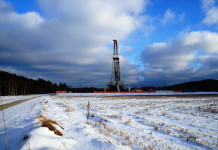SALEM, Ohio – Wet weather plaguing area farmers this summer took another victim Aug. 2 when damp straw spontaneously combusted, igniting a barn full of equipment, hay and straw at Myron Wehr’s farm in New Waterford, Ohio.
After 12 hours of firefighting and 120,000 gallons of water, the fire consumed a barn, two tractors, two wagons, a combine and 5,000 bales of hay and straw, according to New Waterford Fire Department Fire Chief Bryan Henderson. No one was injured.
Wehr said he will have to replace the barn and equipment to maintain his 2,000-acre cash grain and custom work operation.
At the scene. The volunteer department was sitting down to a barbecue chicken dinner at the fire department when a passerby slowed to say a barn was burning down the road.
Firefighters immediately saw the smoke from a mile away and arrived at Wehr’s farm at 3:42 p.m., Henderson said.
Flames and smoke engulfed the 60-foot-by-120-foot barn when firefighters arrived, Henderson said. A machinery shed was also on fire, however firefighters were able to immediately extinguish it, he said.
Fire departments from East Palestine and Columbiana also responded.
Firemen left the scene after 3 a.m. Aug. 3, only to return hours later to put out the still-smoking remnants.
The culprit. Although Henderson said the fire had not been burning long, he said the wet forage could have been smoldering for weeks.
The straw, which had pieces of grass and weeds, was too wet for storage, Henderson said, causing it to heat to the point of spontaneous combustion.
With such a damp season and continued humidity, hay isn’t drying as usual, placing farmers at risk. Wehr urges farmers who stored borderline-dry hay to check the mow temperatures often.
Bright outlook. Despite the wreckage, Wehr is positive.
“The physical things can all be replaced,” he said. “We’ll work through this. There’s been fires at other farms, too.”
* * *
Wet weather increases risk of hay fires in barns
SALEM, Ohio – As if farmers don’t have enough wet-weather worries to agonize over, the danger of spontaneous combustion in hay mows also plagues them.
With this summer’s rain and humidity, the risk for hay fires is particularly high, according to Ohio State University forage specialist Mark Sulc.
A normal moisture level for stored hay is 13 percent to 14 percent, he said. At this level, some heating is common and temperatures may reach 130 degrees during the first few days it is stored.
With the moisture left in the hay, enzymes begin producing mold and microbes, also creating heat, Sulc said.
When too much moisture is left in the hay, these enzymes work overtime, creating even more heat. By the time temperatures hit 170 degrees, the risk for spontaneous combustion is high, Sulc said.
Molds die but other chemical reactions start to increase the temperature even higher – as high as 200-300 degrees, he said.
Dangerous moisture levels for small square bales without a preservative are 20 percent to 25 percent, Sulc said. In large bales, it is 17 percent to 18 percent moisture. At these percentages, the hay should not be stored.
– Kristy Hebert
Get 4 Weeks of Farm and Dairy Home Delivered









